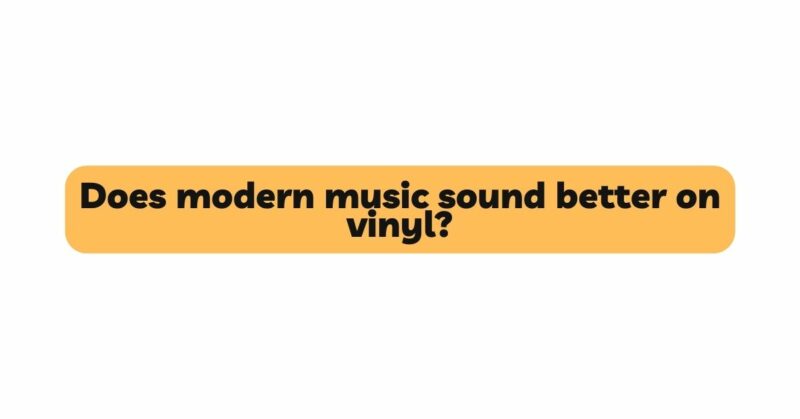The vinyl resurgence has taken the world by storm, with a growing number of music enthusiasts embracing the format as a preferred way to experience their favorite tunes. But amidst the nostalgic allure and tactile experience that vinyl offers, a pertinent question arises: Does modern music sound better on vinyl? In an era dominated by digital convenience and streaming platforms, this article delves into the intricacies of sound quality, production techniques, and the subjective experience of listening to modern music on vinyl.
The Vinyl Renaissance: A Digital Counterpoint
In the digital age, where music is accessible with the tap of a screen, the vinyl revival might seem paradoxical. However, it’s precisely this era of digital dominance that has fueled the resurgence of analog formats. Vinyl records present an alternative way to engage with music—a deliberate act that involves interacting with physical media. This resurgence is driven by a desire for a more immersive and authentic experience, qualities that some argue make modern music sound better on vinyl.
The Analog Warmth: A Timeless Appeal
One of the primary arguments in favor of the vinyl experience is the famed “analog warmth.” Advocates claim that vinyl records, through their analog production process, imbue music with a unique, warm, and natural sound. Vinyl’s limitations, such as surface noise and inherent imperfections, contribute to a sense of organic authenticity that many find missing in digital reproductions. As such, when modern music is pressed onto vinyl, it can inherit some of these analog qualities, potentially enhancing the overall listening experience.
The Vinyl Production Process
To understand whether modern music sounds better on vinyl, it’s crucial to delve into the vinyl production process. Vinyl records are created through an intricate process involving mastering, cutting, and pressing. When modern music is prepared for a vinyl release, mastering engineers often take special care to optimize the sound for the format. This process involves adjusting the dynamics and frequencies to suit vinyl’s limitations and strengths. Thus, modern music releases on vinyl are tailored to the format’s characteristics, potentially resulting in a unique sonic profile.
Digital Source vs. Analog Output
Critics of vinyl argue that the quality of modern music on vinyl might be compromised due to the fact that much of today’s music is digitally recorded, mixed, and mastered. The argument goes that pressing digitally produced music onto vinyl might not fully exploit the format’s potential, as vinyl is inherently analog. While this concern is valid, proponents of vinyl contend that, with proper care and expertise, the transition from digital to analog can preserve the essence of the music, creating a hybrid experience that capitalizes on both formats’ strengths.
Vinyl as an Intentional Experience
Listening to modern music on vinyl is not just about sound quality—it’s a multisensory journey. The act of carefully placing the needle, observing the spinning disc, and engaging with cover art and liner notes transforms the listening experience into an intentional ritual. This ritualistic engagement encourages active listening, as opposed to the passive background consumption often associated with digital streaming. This heightened level of engagement can lead to a deeper connection with the music, making it subjectively sound better to some listeners.
Subjective Perception and Nostalgia
The appreciation of vinyl’s sonic qualities is, to a significant extent, subjective. Individuals who grew up with vinyl or were exposed to older recordings might perceive vinyl as the “true” way to experience music. Nostalgia plays a pivotal role, as the crackling and pops associated with vinyl evoke memories of earlier times. This sentimental attachment can color one’s perception of sound, leading to the belief that modern music sounds better on vinyl.
Quality of Pressings
An important consideration in evaluating whether modern music sounds better on vinyl is the quality of the pressings themselves. With the resurgence of vinyl, pressing plants have had to meet increased demand, potentially leading to variations in quality. High-quality pressings crafted with attention to detail can deliver impressive sound quality, allowing modern music to shine on vinyl. However, inferior pressings can result in a subpar listening experience, overshadowing the benefits of the format.
Conclusion
The question of whether modern music sounds better on vinyl is multi-faceted and subjective. Vinyl’s resurgence is not solely about sound quality; it’s a convergence of tactile interaction, ritualistic engagement, and a return to a slower-paced music consumption. The analog warmth and imperfections that vinyl imparts can infuse modern music with a unique character, fostering a connection between listener and artist. While concerns about the compatibility of digital recordings with analog formats exist, advances in mastering and pressing techniques mitigate potential drawbacks.
Ultimately, the allure of modern music on vinyl lies in the tapestry of experiences it weaves—the sensory engagement, the appreciation of artwork, and the tangible connection with the music. Whether modern music truly sounds “better” on vinyl is a matter of individual perspective, colored by nostalgia, personal preferences, and the desire for a more intentional and immersive musical journey.


